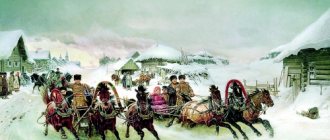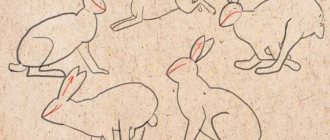How and when to start playing music?
At 3 years old, the baby understands speech well and is already able to tell something himself. However, learning sheet music for children of this age can only hinder their musical development. Therefore, from the age of 3, it is recommended to begin activities that are not related to musical literacy. They usually include various games aimed at the following purposes:
- developing an understanding of the pitch and timbre of sounds;
- listening and analyzing musical works;
- playing children's musical instruments;
- singing.
From the age of 4-5, when the child already recognizes the letters, you can begin to master musical notation - but not earlier, because until this age the child feels music well even without it. This way, the ear for music develops better, and the child will be able to master many more works.
Sheet music for children's songs
There are two different effects of singing on a child: direct and indirect.
Direct influence includes those aspects that arise in the body or psyche of a person directly under the influence of singing. Indirect influence, however, includes those aspects that will arise under the influence of the mood created by voice music.
Another division, also arising from the above, will be the influence on physical development (physics) and simultaneous psycho-emotional development (psyche).
Essential here is the fact that singing simultaneously affects various aspects of our personality and, regardless of age, it produces energy, which is the driving force of emotional and psychophysical development. Thus, singing simultaneously affects different categories of human development.
It’s a great practice to play a melody on a musical instrument for your child and sing with him, to live accompaniment! You can download sheet music for many popular songs on this page above.
Considering the physical development of children, we notice that under the influence of singing, the respiratory, cardiovascular, digestive and nervous systems develop and improve, which has further consequences in the mechanisms of vital functions associated with the muscles of the body. Children usually naturally combine singing and movement, emphasizing the rhythm contained in the song. This tendency, well used by a wise parent or teacher, results in a better body and better posture.
Separately, we can highlight the influence of singing on the development of speech, since the wealth of influence in this area is enormous. First of all, singing with adults makes this form of communication more attractive. In addition, it expands vocabulary and expressive abilities. The rhythm of the song itself also stimulates speech development, satisfying the child’s natural needs associated with the physiological rhythm of the body.
In the case of the psyche, we notice a clear effect on releasing emotions, improving mood, creating a sense of security and courage in self-expression. Children who sing are cheerful, calm and brave. Singing also supports attention (concentration), memory and imagination.
Sensitivity to the quality of the sound produced prevents diseases of the larynx and the formation of nodules that can occur if you shout frequently. At the same time, through singing, the child develops a culture of expression and interpersonal understanding.
It is also an excellent cure for all mental stress, fears and worries and aggression.
Singing releases accumulated emotions, both pleasant and unpleasant, making it easier for the child to maintain harmony and emotional balance.
It is worth emphasizing the exceptional role of lullabies, which, when sung with a child before bed, relax the body, reduce tension, soften the effects of various sensations during the day and deepen the emotional relationship between child and parent.
Development of musical abilities of a child 3–6 years old
To begin with, try acting out a fairy tale with your child (preferably with two characters), where the adult will play the role of a hero with a low timbre of voice, and the child will play with a high timbre (for example, a wolf and a fox). In this case, you need to discuss in advance with the child what voices the characters will have. If possible, you can stage a fairy tale with a large number of characters, involving other family members in the participation. You can also voice children's toys.
Next, we try to listen to a musical fairy tale, for example, “Peter and the Wolf” by Prokofiev:
- First, tell your child the plot of the fairy tale, explain what musical instruments represent each character, what height they are (for example, the bird is represented by a gentle and melodic flute, the grandfather and the wolf are lower instruments).
- Let your child try to identify the character by timbre while listening, and you will help him if necessary.
It is very good not only to listen to music, but also to talk about it. After listening, ask your child to tell him what he heard in this music, what it is like. Children are usually very good at identifying the nature of a melody and finding suitable adjectives. If your child has difficulty with this, tell him the right words. Thus, the baby will not only begin to feel music more deeply, but will also significantly enrich his vocabulary.
It is also good to ask your child to draw music - this contributes to a better perception of the work.
Introduction to musical instruments and singing
Familiarity with various musical instruments plays an important role in the overall musical development of a child. For starters, these could be several children's tools, for example:
- pipe;
- children's guitar;
- drum.
Before you start getting acquainted with the guitar, you can take two fishing lines: thinner and thicker, pull them tightly and let your child pluck them one by one. Thin line will produce a higher sound, while thick line will produce a lower sound. It shouldn’t be too difficult for a child to determine this.
After this, you can give him a children's guitar: let him pluck each string in turn and determine its height. It is necessary to draw the child’s attention to the fact that the thicker the string, the lower the sound, and vice versa.
Vocal-playing exercises, which are based on singing simple melodies and scales, are very useful for musical development:
- To begin, together with your child, draw on a large piece of paper a ladder consisting of seven steps up and down. Along this “ladder” you will sing a scale (7 gradually increasing and then decreasing notes). To do this, you need to take a small toy that will move along this “ladder” along with your voice.
- Sing the first note (any note), maybe “ta-ta”, “la-la” or other sounds, at the same time put the toy on the 1st step. Sing the next note (a little higher), place the toy on the 2nd step, etc., and then, also along the “ladder”, down.
Thematic catalog
Sheet music of songs for piano on various topics for children of preschool and primary school age, for singing in kindergarten, primary school, and as a family with their children
Sheet music of songs for children about different seasons (winter, spring, summer, autumn)
Sheet music of children's songs for Russian folk holidays (Christmastide, Easter, Maslenitsa)
Sheet music of children's songs for calendar holidays (New Year, March 8, May 9, February 23)
Sheet music for children's songs for themed holidays (graduation, fall, birthday, traffic rules)
Sheet music for songs on various topics (about animals, transport, nature, lullabies)
Sheet music of songs, games, exercises and dances for little ones (2-3 years old)
Sheet music of popular children's songs from domestic and foreign cartoons and films
Sheet music of piano works without words for children (DMI, listening, polka, waltz, march)
Source
How to tell about notes?
Before you introduce your child to notes, you need to explain to him what they are.
Notes are recorded sounds. Just as we write our speech in letters, so music is written in notes. There are a huge variety of notes: both high and low, but they are all divided into 7 basic ones, which everyone knows: do, re, mi, fa, salt, la, si.
The notes live on a musical staff, which consists of 5 lines. The notes can be located either directly on these lines, or between them, they can also be under and above the lines, and on additional lines that we draw above or below.
Draw a staff of music on a large sheet of paper and write notes in a row on it (you can color them in different colors). Then sing them all together with your child.
To make your child interested in learning notes, you can show him a cartoon about the notes “Do Re Mi.”
A start has been made - the child has a general understanding of notes. Only after showing interest in notes can you start learning them seriously (it’s better to do this on another day).
New Year and winter songs with notes
1. The Christmas tree came to the children, bringing snow on its branches. We need to warm up the Christmas tree, put on a new dress.
2. The stars shine brightly, the light bulbs burn brightly. Various beads hang - Wonderful outfit.
3. Musicians hurry up and play more fun! Let's dance together in a round dance - Hello, hello, New Year!
1. We play snowballs boldly, Oh, what does it matter? We love a frosty day, We are not too lazy to play snowballs.
Chorus: Clap, clap, don't yawn, Don't run away from us. Clap, clap, don't yawn, Now throw it at me.
2. Let the winter freeze us, We will warm ourselves now: Let's clap our hands, Stomp our feet!
Chorus.
We invited the green Christmas tree How elegant the Christmas tree is in our hall!
Chorus: Christmas tree, Christmas tree! Just a sight for sore eyes! Both fluffy and slim, to everyone's surprise!
White snowstorms are swirling outside the windows there are games and fun at our Christmas tree
Chorus.
We're having fun today. It's such a good day! Everyone is dancing around the Christmas tree, clapping their hands!
Chorus.
The snow is deep in the forest in winter, There are no paths anywhere, But long ago the hedgehog hid in a hole from the cold. Let the frost get stronger and the snowstorm become stronger, The hedgehog has a warm bed. And let the blizzard whistle and howl, the hedgehog closes his eyes, really wants to sleep. So he turned on the other side, and the forest animal fell asleep, fell asleep...
It’s good to squeak with galoshes on uncrushed snow, It’s good to be friends with good, brave guys!
It’s good to walk down the street And look with all your eyes, It’s good to squint from the sun, Rub your red cheeks!
Chorus: One - two, Walk wider, One - two, Breathe deeper! Don't lag behind And don't rush - Walk!.. walk!.. walk!..
It’s good to joke with people you meet, Kind passers-by, It’s good to grow warm-hearted, Friendly, handsome.
It’s good that this glorious big day doesn’t end... It’s good that we encounter so many “good things!”
Chorus.
Enchanted by gray frost, the silent winter forest sleeps. And on the needles of the pine paws Snowflakes fall from the sky. There was a white snowstorm here just yesterday.
Here there are heavy flocks of wood grouse , And white hares in the blizzard, Martens, foxes, ermines, As if on a feather bed, they sleep in the snow. A bear sleeps in a den, and a squirrel sleeps in a hollow.
Through the pine forest the moose carries her proud beauty, It was so snowy, quiet, quiet in the winter in the wind-covered forest.
Here it is, our Christmas tree, in the brilliance of radiant lights! It seems that she is more beautiful than everyone else, greener and more lush than everyone else.
A fairy tale is hiding in the greenery, a white swan is swimming, a bunny is sliding on a sled, a squirrel is gnawing on nuts.
Here it is, our Christmas tree, in the brilliance of radiant lights! It seems that she is more beautiful than everyone else, greener and more lush than everyone else.
He is big and club-footed. He sucks his paw in winter. And when spring comes, He awakens from sleep.
Near the elegant Christmas tree, Near the prickly Christmas tree, the kindergarten is having fun. Because the best, Because the best This holiday is for the guys.
Chorus: We dance around the Christmas tree. Hello, Christmas tree! Hello New Year!
Together with the Snow Maiden Santa Claus to us again for the New Year's holiday. We will celebrate together today, Together we will celebrate the long-awaited New Year today.
Chorus.
The tree is shining with lights. Adults and children are happy - the desired hour has arrived. And, probably, in the world, And, probably, in the world There are no children happier than us .
Parsleys, Parsleys, Well done, Caps on the tops of their heads, Bells on their caps.
Let's try, brothers, to cheer everyone up, We'll do somersaults, We'll show off our agility.
Parsley, guys, Now let's go dance, Some will squat, And some will do somersaults.
On New Year's Eve, as in a fairy tale, Full of miracles, the Christmas tree hurries to catch the train, Leaving the winter forest. And the stars shine brightly, And they dance in circles On New Year's Eve, On New Year's Eve, On New Year's Eve, New Year's Eve.
Little funny ones, like snowflakes, fly and fly all night. And merry songs sound everywhere. The wind whistles, the Blizzard sings. On New Year's Eve, New Year's Eve, New Year's Eve, New Year's Eve.
Like our Christmas tree, its needles are green.
Chorus: Christmas tree, Christmas tree, Festive Christmas tree, Christmas tree, Christmas tree, Festive Christmas tree.
Everything sparkles with ice flakes, White snowflakes.
Chorus.
Santa Claus will come to us for the New Year along with the Christmas tree.
Chorus.
Subscribe music2babyHow to remember notes and their location on the staff?
First, let's prepare everything we need:
- draw a large musical staff on a piece of paper;
- Let's cut out 7 oval notes the size of a 5-ruble coin.
It is advisable that the notes be colored, like the colors of the rainbow: this way they are better remembered.
Training should take place in several stages:
- First, we learn three notes located on the first three lines: mi, salt, si.
- When the child learns three notes and can identify them in different sequences, we begin to study the notes located between the lines: D, F, A.
- When the child masters both of them and is able to identify both interspersed, we learn the note “C” located on the additional line, and the “C” of the 2nd octave between the third and fourth line.
- After this, ask your child to make a scale of notes, starting with “C” of the 1st octave and ending with “C” of the 2nd octave.
- At the next stage, the child lays out simple melodies from notes, writes them out in an album and performs them on the piano. This stage is especially pleasant for him, because he plays the notes!
- After this, you can safely take children's music books and identify the notes there.
When the child already identifies all the notes well, you can move on to gradually learning everything else: keys, durations, pauses, octaves, etc.
Contemporary music
Entertainment music is a concept that includes all musical genres. It differs from folk or classical. It can be divided into several genres:
- country;
- pop;
- rock;
- jazz and others.
Each of the divisions is constantly evolving, and more and more new styles are emerging. Many modern songs are produced on the piano.
For beginner or experienced pianists, this is an opportunity to play your favorite song by notes.
Useful tips for parents
Here are some tips on how to practice music with your child to keep him interested:
- use your child’s favorite games and toys during classes;
- play “school”, changing the roles of “teacher-student”;
- organize “concerts”, performing at them in turns;
- in between classes, switch the child to other hobbies, for example, read him a fairy tale or draw;
- praising a child - this is how he develops “wings” and awakens interest in activities.
So, the main thing in learning notes is to start no earlier than the child is ready to assimilate information of this kind. Many children, while learning letters, literally “grab on the fly” everything related to musical notation, but provided that they are already well acquainted with music by intuitive perception.
Easy songs from domestic cartoons
At the initial stage, piano or piano sheet music for kids should be simple.
For learning, the best songs for children are those that are familiar to them:
"If only it weren't winter"
Sheet music of the song by Evgeny Krylatov for piano playing from the cartoon “Winter in Prostokvashino”.
"Antoshka"
Sheet music of a children's song from the cartoon "Merry Carousel" by Vladimir Shainsky.
"Song of Captain Vrungel"
Sheet music from the soundtrack to the cartoon "The Adventures of Captain Vrungel". Author – Firtich Georgy Ivanovich.
"In the grass Grasshopper sat"
Vladimir Shainsky’s song “A grasshopper sat in the grass” is suitable for playing the piano 1st grade.
“In the garden or in the vegetable garden”
This is a Russian folk song that can be played on the piano.
"Clouds"
Notes of the song from the cartoon “Hello!” Vladimir Shainsky.
“Tell me, Snow Maiden, how are you?”
Song of the Hare and the Wolf at the carnival from the animated series “Well, wait a minute!” Music by Soviet Russian composer Gennady Gladkov.
"Song about Summer"
Sheet music for the song “Song about Summer” by Evgeny Krylatov from the cartoon “Santa Claus and Summer”.









